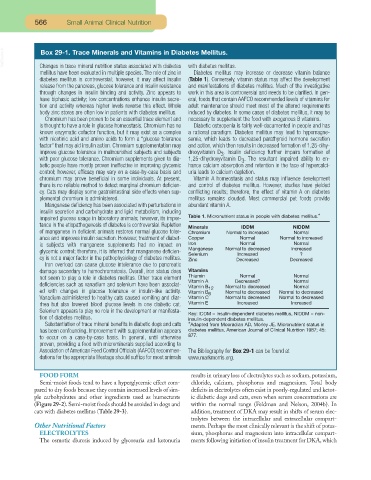Page 547 - Small Animal Clinical Nutrition 5th Edition
P. 547
566 Small Animal Clinical Nutrition
VetBooks.ir Box 29-1. Trace Minerals and Vitamins in Diabetes Mellitus.
Changes in trace mineral nutrition status associated with diabetes
mellitus have been evaluated in multiple species. The role of zinc in with diabetes mellitus.
Diabetes mellitus may increase or decrease vitamin balance
diabetes mellitus is controversial; however, it may affect insulin (Table 1). Conversely, vitamin status may affect the development
release from the pancreas, glucose tolerance and insulin resistance and manifestations of diabetes mellitus. Much of the investigative
through changes in insulin binding and activity. Zinc appears to work in this area is controversial and needs to be clarified. In gen-
have biphasic activity; low concentrations enhance insulin secre- eral, foods that contain AAFCO recommended levels of vitamins for
tion and activity whereas higher levels reverse this effect. Whole adult maintenance should meet most of the altered requirements
body zinc stores are often low in patients with diabetes mellitus. induced by diabetes. In some cases of diabetes mellitus, it may be
Chromium has been proven to be an essential trace element and necessary to supplement the food with exogenous B vitamins.
is thought to have a role in glucose homeostasis. Chromium has no Diabetic osteopenia is fairly well-documented in people and has
known enzymatic cofactor function, but it may exist as a complex a rational paradigm. Diabetes mellitus may lead to hypomagne-
with nicotinic acid and amino acids to form a “glucose tolerance semia, which leads to decreased parathyroid hormone secretion
factor” that may aid insulin action. Chromium supplementation may and action, which then results in decreased formation of 1,25-dihy-
improve glucose tolerance in malnourished subjects and subjects droxyvitamin D . Insulin deficiency further impairs formation of
3
with poor glucose tolerance. Chromium supplements given to dia- 1,25-dihydroxyvitamin D . The resultant impaired ability to en-
3
betic people have mostly proven ineffective in improving glycemic hance calcium absorption and retention in the face of hypercalci-
control; however, efficacy may vary on a case-by-case basis and uria leads to calcium depletion.
chromium may prove beneficial in some individuals. At present, Vitamin A homeostasis and status may influence development
there is no reliable method to detect marginal chromium deficien- and control of diabetes mellitus. However, studies have yielded
cy. Cats may display some gastrointestinal side effects when sup- conflicting results; therefore, the effect of vitamin A on diabetes
plemental chromium is administered. mellitus remains clouded. Most commercial pet foods provide
Manganese deficiency has been associated with perturbations in abundant vitamin A.
insulin secretion and carbohydrate and lipid metabolism, including
impaired glucose usage in laboratory animals; however, its impor- Table 1. Micronutrient status in people with diabetes mellitus.*
tance in the etiopathogenesis of diabetes is controversial. Repletion Minerals IDDM NIDDM
of manganese in deficient animals restores normal glucose toler- Chromium Normal to increased Normal
ance and improves insulin secretion. However, treatment of diabet- Copper Normal Normal to increased
ic subjects with manganese supplements had no impact on Iron Normal Normal
glycemic control; therefore, it is inferred that manganese deficien- Manganese Normal to decreased Increased
?
Selenium
Increased
cy is not a major factor in the pathophysiology of diabetes mellitus. Zinc Decreased Decreased
Iron overload can cause glucose intolerance due to pancreatic
damage secondary to hemochromatosis. Overall, iron status does Vitamins
Normal
not seem to play a role in diabetes mellitus. Other trace element Thiamin Decreased? Normal
Vitamin A
Normal
deficiencies such as vanadium and selenium have been associat- Vitamin B Normal to decreased Normal
ed with changes in glucose tolerance or insulin-like activity. Vitamin B 12 Normal to decreased Normal to decreased
6
Vanadium administered to healthy cats caused vomiting and diar- Vitamin C Normal to decreased Normal to decreased
rhea but also lowered blood glucose levels in one diabetic cat. Vitamin E Increased Increased
Selenium appears to play no role in the development or manifesta- Key: IDDM = insulin-dependent diabetes mellitus, NIDDM = non-
tion of diabetes mellitus. insulin-dependent diabetes mellitus.
Substantiation of trace mineral benefits in diabetic dogs and cats *Adapted from Mooradian AD, Morley JE. Micronutrient status in
has been confounding. Improvement with supplementation appears diabetes mellitus. American Journal of Clinical Nutrition 1987; 45:
to occur on a case-by-case basis. In general, until otherwise 877.
proven, providing a food with microminerals supplied according to
Association of American Feed Control Officials (AAFCO) recommen- The Bibliography for Box 29-1 can be found at
dations for the appropriate lifestage should suffice for most animals www.markmorris.org.
FOOD FORM results in urinary loss of electrolytes such as sodium, potassium,
Semi-moist foods tend to have a hyperglycemic effect com- chloride, calcium, phosphorus and magnesium. Total body
pared to dry foods because they contain increased levels of sim- deficits in electrolytes often exist in poorly-regulated and ketot-
ple carbohydrates and other ingredients used as humectants ic diabetic dogs and cats, even when serum concentrations are
(Figure 29-2). Semi-moist foods should be avoided in dogs and within the normal range (Feldman and Nelson, 2004b). In
cats with diabetes mellitus (Table 29-3). addition, treatment of DKA may result in shifts of serum elec-
trolytes between the intracellular and extracellular compart-
Other Nutritional Factors ments. Perhaps the most clinically relevant is the shift of potas-
ELECTROLYTES sium, phosphorus and magnesium into intracellular compart-
The osmotic diuresis induced by glycosuria and ketonuria ments following initiation of insulin treatment for DKA, which

